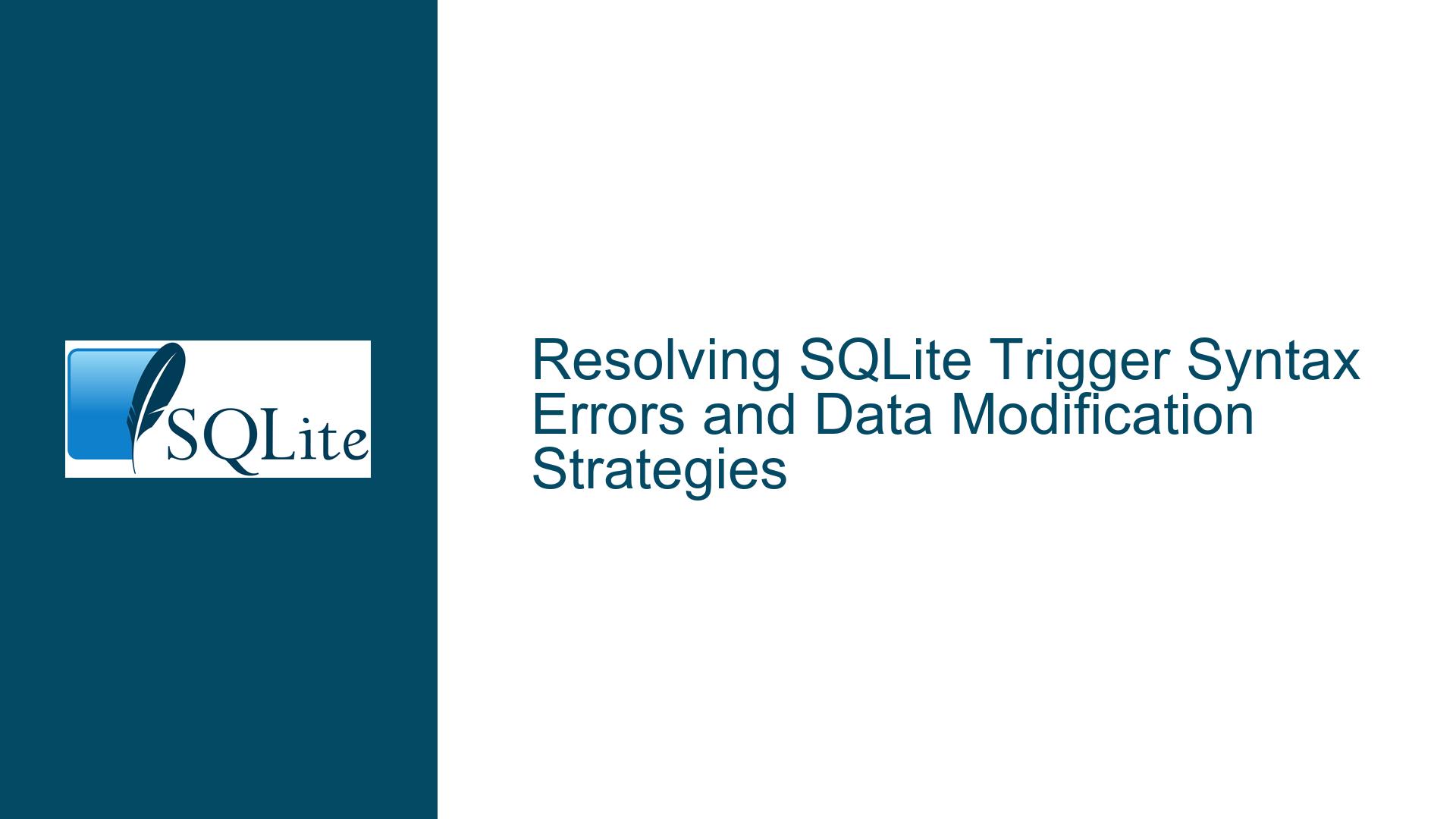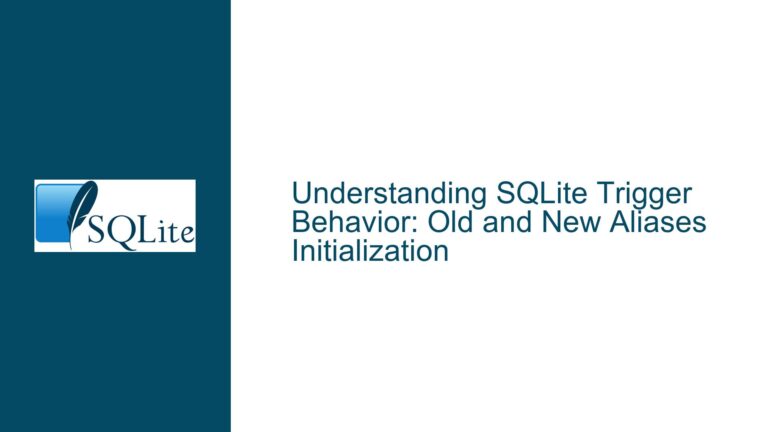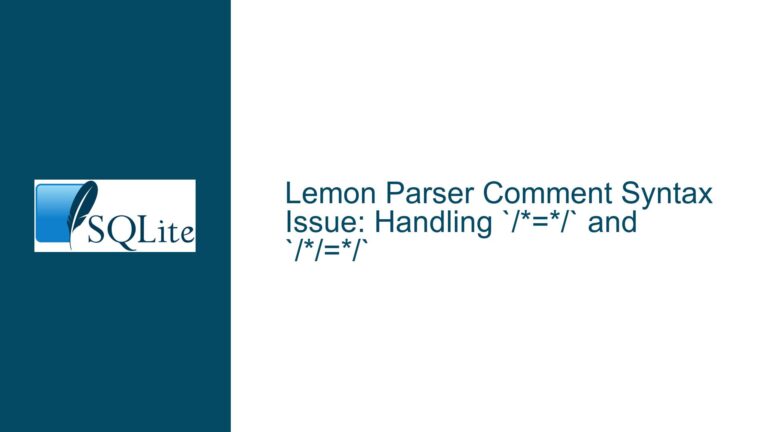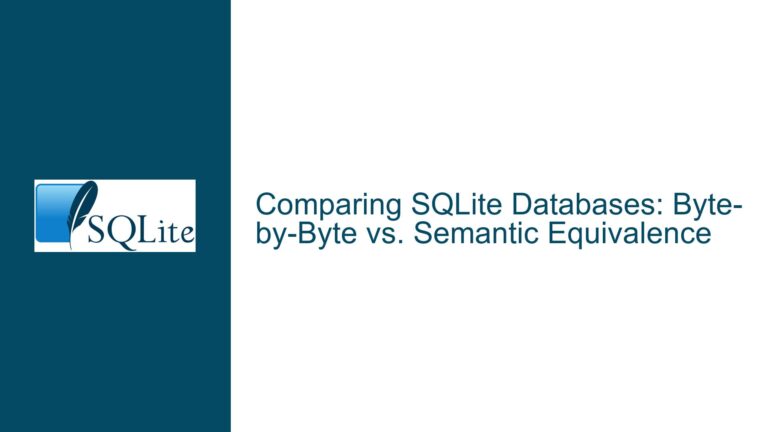Resolving SQLite Trigger Syntax Errors and Data Modification Strategies
Understanding SQLite Trigger Limitations and Data Manipulation Goals
Issue Overview: Syntax Errors When Attempting to Modify NEW Values in BEFORE INSERT Triggers
The core issue revolves around attempting to replicate procedural-style trigger logic (common in databases like PostgreSQL) in SQLite, specifically within a BEFORE INSERT trigger. The user aims to enforce data formatting rules (e.g., converting col1 to lowercase and col2 to uppercase) before inserting a row. In PostgreSQL, this is straightforward with a trigger that modifies NEW.col1 and NEW.col2 directly. However, in SQLite, the same approach fails with a syntax error at the reference to NEW.col1.
SQLite’s trigger system is fundamentally different from databases that support procedural languages (PL/pgSQL, T-SQL, etc.). Triggers in SQLite cannot directly modify the values of the NEW pseudo-table using assignment operators (:= or =). Instead, triggers must use standard SQL statements (INSERT, UPDATE, DELETE, or SELECT) to achieve similar outcomes. This design limitation stems from SQLite’s lightweight architecture, which avoids embedding a procedural language interpreter.
The user’s original trigger code:
CREATE TRIGGER my_trigger BEFORE INSERT ON my_table
BEGIN
NEW.col1 = lower(NEW.col1); -- Syntax error here
NEW.col2 = upper(NEW.col2);
END;
Fails because SQLite does not recognize the assignment of values to NEW.col1. This misunderstanding leads to confusion about how to enforce data transformations during insertion efficiently.
Possible Causes: Misalignment Between SQLite Trigger Syntax and Procedural Expectations
1. SQLite’s Restriction to Pure SQL in Triggers
SQLite triggers are constrained to executing standard SQL statements and cannot execute procedural code. Unlike PostgreSQL, which allows direct modification of NEW values using PL/pgSQL, SQLite requires all trigger logic to be expressed through DML operations. The NEW pseudo-table is read-only in BEFORE INSERT triggers; attempting to modify it via assignment is syntactically invalid.
2. Misinterpretation of Trigger Execution Context
A BEFORE INSERT trigger in SQLite fires before the row is written to the table. At this stage, there is no row to update because the insertion has not yet occurred. This means:
- Directly modifying
NEWvalues is impossible. - Any data transformation must be achieved by inserting a new row (with modified values) and canceling the original insertion.
3. Overhead Concerns With Workarounds
The user’s concern about performance overhead arises from suggestions to use AFTER INSERT triggers with UPDATE statements. While functional, this approach requires two operations (insert followed by update), which could be inefficient for bulk inserts. However, SQLite’s optimizations (e.g., write-ahead logging) mitigate this overhead in practice.
Troubleshooting Steps and Solutions: Achieving Data Transformation in SQLite Triggers
1. Using BEFORE INSERT Triggers With INSERT and RAISE(IGNORE)
Step 1: Create a Trigger to Insert Modified Values
Modify the BEFORE INSERT trigger to insert a new row with transformed values and then abort the original insertion:
CREATE TRIGGER enforce_format BEFORE INSERT ON my_table
FOR EACH ROW
BEGIN
INSERT INTO my_table (col1, col2)
VALUES (lower(NEW.col1), upper(NEW.col2));
SELECT RAISE(IGNORE);
END;
How It Works:
- The trigger intercepts the original
INSERToperation. - It inserts a new row with
col1andcol2transformed. RAISE(IGNORE)cancels the original insert, preventing duplication.
Step 2: Handle Recursive Triggers
By default, SQLite disables recursive triggers. If enabled, the trigger would fire again for the new INSERT, causing an infinite loop. Ensure recursive_triggers are off:
PRAGMA recursive_triggers = 0; -- Default setting
Step 3: Add Conditional Logic to Avoid Redundant Operations
To optimize performance, use a WHEN clause to execute the trigger only if transformations are needed:
CREATE TRIGGER enforce_format BEFORE INSERT ON my_table
FOR EACH ROW
WHEN NEW.col1 <> lower(NEW.col1) OR NEW.col2 <> upper(NEW.col2)
BEGIN
INSERT INTO my_table (col1, col2)
VALUES (lower(NEW.col1), upper(NEW.col2));
SELECT RAISE(IGNORE);
END;
2. Using INSTEAD OF Triggers on Views
Step 1: Create a View and Trigger
For more flexibility, use a view and an INSTEAD OF trigger:
CREATE VIEW my_view AS SELECT * FROM my_table;
CREATE TRIGGER view_enforce_format INSTEAD OF INSERT ON my_view
FOR EACH ROW
BEGIN
INSERT INTO my_table (col1, col2)
VALUES (lower(NEW.col1), upper(NEW.col2));
END;
How It Works:
- Applications perform
INSERToperations onmy_viewinstead ofmy_table. - The trigger intercepts the insert and applies transformations before writing to the base table.
Step 2: Handling Bulk Inserts
INSTEAD OF triggers handle multi-row inserts efficiently:
INSERT INTO my_view (col1, col2) VALUES
('Value1', 'value2'),
('Value3', 'value4');
The trigger processes each row individually without recursion issues.
3. Using AFTER INSERT Triggers With Updates
Step 1: Create an AFTER INSERT Trigger
If transformations can tolerate a two-step process, use:
CREATE TRIGGER update_after_insert AFTER INSERT ON my_table
FOR EACH ROW
BEGIN
UPDATE my_table
SET col1 = lower(NEW.col1), col2 = upper(NEW.col2)
WHERE id = NEW.id;
END;
Step 2: Optimize With Conditional Logic
Add a WHEN clause to skip unnecessary updates:
CREATE TRIGGER update_after_insert AFTER INSERT ON my_table
FOR EACH ROW
WHEN NEW.col1 <> lower(NEW.col1) OR NEW.col2 <> upper(NEW.col2)
BEGIN
UPDATE my_table
SET col1 = lower(NEW.col1), col2 = upper(NEW.col2)
WHERE id = NEW.id;
END;
Performance Considerations:
- The
UPDATEis part of the same transaction as theINSERT. - SQLite’s
REPLACEconflict resolution can minimize write overhead.
4. Using Generated Columns for Static Transformations
If transformations are deterministic, use generated columns:
CREATE TABLE my_table (
id INTEGER PRIMARY KEY,
raw_col1 TEXT,
raw_col2 TEXT,
col1 TEXT GENERATED ALWAYS AS (lower(raw_col1)) VIRTUAL,
col2 TEXT GENERATED ALWAYS AS (upper(raw_col2)) VIRTUAL
);
Limitations:
- The original values (
raw_col1,raw_col2) are stored, which may not align with the goal of enforcing formats.
Performance Optimization and Best Practices
1. Bulk Insert Strategies
- Use
BEGIN TRANSACTIONandCOMMITto wrap bulk inserts:BEGIN TRANSACTION; INSERT INTO my_table (...) VALUES (...); INSERT INTO my_table (...) VALUES (...); COMMIT; - Disable triggers temporarily if raw data is pre-validated:
PRAGMA defer_foreign_keys = 1; -- Optional, if foreign keys are involved
2. Benchmarking Trigger Approaches
- Compare execution times for 10,000-row inserts using:
.timer ONin the SQLite CLI.
3. Avoiding Recursive Triggers
- Use
PRAGMA recursive_triggersjudiciously. Most use cases do not require enabling this setting.
Conclusion
SQLite’s trigger system requires a paradigm shift for developers accustomed to procedural SQL dialects. By leveraging BEFORE INSERT with RAISE(IGNORE), INSTEAD OF triggers on views, or optimized AFTER INSERT updates, you can enforce data formatting rules efficiently. Each approach has trade-offs in complexity, performance, and maintainability, but understanding SQLite’s constraints allows for robust solutions tailored to specific use cases.






